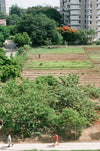
06/2021 architecture & interior
The global peasant movement La Vía Campesina coined the term “food sovereignty” in 1996. Unlike food security, which in its basic form means to have access to sufficient, nutritious food, food sovereignty also covers people’s right to define agricultural strategies, including access to land, water, and other resources, prioritizing local, ecologically appropriate production, fair conditions for agricultural workers, and affordable access to seeds.
The world’s largest organic farming experiment took place in Cuba during the early 1990s. In the 1980s, the island’s economy had hinged upon trade with the Soviet Union. The collapse of the latter meant the end of high-input agriculture for Cuba. The island was forced to transition almost overnight from an industrial food system that relied heavily on agrochemicals and imports to a self-sustaining, agroecological, local approach to food production. During the “Special Period” that followed, thousands of popular urban gardens emerged out of necessity. The grassroots response to the food shortages brought about by the loss of trade with the Soviet Union soon received formal government support. Today, the country is widely considered a pioneer in urban agriculture. As stated in research led by Professor Miguel Altieri, 50% of the fresh food on the island is produced in urban and peri-urban agricultural settings.
Seed saving is crucial for food sovereignty and central in the work of agronomist Dr. Humberto Ríos Labrada, a Goldman Environmental Prize winner for his contribution to agricultural transformation in Cuba. “When the crisis came to Cuba, one of the sectors that collapsed first was the seeds,” he says. “I traveled around the country collecting seeds mostly from small farmers who had been discriminated against by the Green Revolution model.”
Cuba was forced to transition almost overnight from an industrial food system to a local, agroecological model
Labrada considers the participative dissemination of seeds his biggest contribution to the drastic reform in the country’s food system. “For the first time in the history of Cuba, I asked small farmers, rural and peri-urban, which seeds they wanted to select. Later, urban farmers followed,” he says. “We started with around 25 farmers, and in a few years, we had a network of 50,000.” Each small farmer who took part in the first seed fair then went on to organize similar fairs, promoting seed saving, seed sharing, and local agricultural production. “In Havana, like any other big city, there are people from many places, and their criteria to select seeds are even more diverse. People select different seeds depending on their culture. It’s a beautiful way of trying to increase biodiversity,” he explains.
Vivero Alamar is a successful organopónico (urban garden) located in the Havana suburbs. Run as a cooperative with over 150 members, it stands in a high-density area, offering the community easy access to affordable, fresh produce. Fruit and vegetables are grown following an intensive organic farming model. The garden is run as a circular ecosystem where everything from manure to compost is managed in-house. Another example of urban agriculture in the capital is La Sazón, an organopónico that is sandwiched between buildings in a high-density area. As with all organopónicos, La Sazón is government-regulated, selling its organic produce directly to consumers at low prices. By encouraging the participation of residents and empowering communities, the urban agriculture movement in Cuba gained social acceptance; it created jobs, offered affordable, organic produce, and beautified neglected areas.
Leah Penniman, the founding co-director of Soul Fire Farm and author of the book Farming While Black, works toward ending racism and injustice in the food system. Food deserts—areas with a lack of buyable fresh produce—are a visible symbol of food injustice in the United States. Penniman considers the situation food apartheid, a term coined by activist Karen Washington. “It’s not a natural desert, it’s a human-created system of segregation,” she says. “You can trace it back to a history of redlining housing discrimination and restrictive zoning, as to why folks of color predominantly live in certain neighborhoods, and these neighborhoods have a scarcity of farmers’ markets, grocery stores, fresh food outlets, and also have low income and no wealth. It’s that history of systemic racism that has resulted in this ghettoization of food.”
Today 50 percent of the fresh food on the island is produced in urban and peri-urban agricultural settings
From her Upstate New York farm, Penniman runs several programs that address vital food sovereignty issues affecting underserved communities, providing families with the tools and guidance to grow their own produce. “One of these programs is Soul Fire in the City, which builds raised bed gardens for survivors of food apartheid in our local area of Albany and Troy,” she says. “There are just under 50 families in the program. Each family gets the lumber and hardware. The raised bed is built by our volunteers, set with compost and topsoil. We bring the seeds and plants and have several classes, as well as a phone-a-farmer hotline, so they can call and get advice about their garden. It’s been beautiful because especially during the pandemic, we heard from families that this is not only a crucial source of food but also a source of connection for their children to the earth, a family activity that is helpful and hopeful in times of despair, so that’s been very meaningful.”
Improving access to local, healthy food for underprivileged communities is part of East New York Farms!’s mission too. “At our Pink Houses farm, all the produce grown gets distributed to the community for free,” explains Iyeshima Harris, the project’s director. The community farm, located in the Pink Houses public housing complex, grows around 21,000 kilograms (46,000 pounds) of produce annually. Volunteers, youth program interns, and Pink Houses residents help maintain the space.
Growing food in urban settings can take many forms, from an individual act to a collective effort. It may not be realistic to feed entire cities on locally grown food, but urban agriculture can be a significant part of the solution to achieve fairer levels of food access, especially if approached from an equity lens.
Urban Farmers - The Now (and How) of Growing Food In The City.








